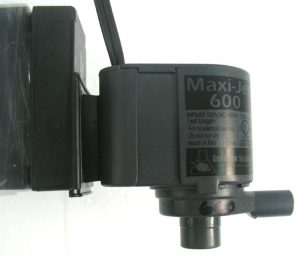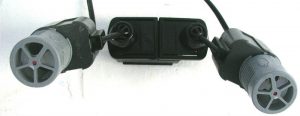Some simple yet eloquent products have recently become available to reef hobbyists and it makes me wonder why someone didn’t think of these solutions a long time ago. This month’s Product Review will examine the application of simple magnets and how these products can benefit both hobbyists and captive livestock.
Note: This article has been in preparation for over one year, and originally contained references to products no longer available. The two ‘magnetic’ products reviewed here have been around for a while and have performed well. Algae Free’s ‘Rotation Bracket’ for modified Maxi-Jet powerheads is relatively new, so preliminary observations are presented below.
Frag-Mag
We had so many unanswered questions in the pioneering days of the reef hobby in the United States. One major problem was holding corals in place until they could grow and attach on their own to the substrate. It seemed everyone had a favorite ‘adhesive’ ranging from expensive ‘industrial’ underwater epoxies (with a cure time of 24 hours) to rubber bands, toothpicks, and even chewed bubble gum (!). Years later, while managing a large-scale propagation facility, we relied upon eggcrate and plastic flower picks to hold coral fragments and broodstock in place. Of course, we now have fast-setting ‘reef safe’ epoxy and various ‘super glues’. These work fine but have a disadvantage of pretty much permanently mounting a specimen in place. In addition, mounting large coral specimens in an existing aquarium with any of the various glues can be a challenge and especially so to sloped or vertical surfaces. For researchers, there exists a paradox of keeping a specimen in place yet having
the luxury of easy removal for various testing procedures.
Aqua Mags (www.aqua-mags.com) has introduced a clever solution for these situations.
Their ‘magnetic coral attachment system’ includes two reef-safe magnets, one of which is coated with a fine, inert black ‘gravel’. Fragments or colonies are adhered with any of your choice of available glues, and once the glue has cured, the piece and its magnetic base are held in place by the ‘pull’ of the other magnet. Mounting corals on the bottom, side walls or back of an aquarium becomes easy and opens the possibility of some unique aquascaping arrangements (See Figures 1 and 2). I use Frag-Mags to hold specimens temporarily in place while performing photosynthesis experiments with a PAM fluorometer, fluorescence/reflectance analyses as well as positioning corals for photographic purposes. The ability to incrementally move a particular coral during its ‘light adaptation’ period after transfer to a new home should also be of benefit.
Originally available in 3 sizes, Aqua Mags now offers a ‘one-size-fits-all’ approach and offers ‘large’ magnets that are sufficient to hold most fragments and many colonies in place on glass or acrylic up to ¾” thick. The black sand-encrusted base to which the coral fragment is glued is ~1″ in diameter. Gluing one magnet to eggcrate while leaving the other base magnet and coral held in check by magnetism is also an option (especially viable if you have a lot of water circulation).
Advertised prices at the time of this writing are $5.95 for each Frag Mag set or three sets for $16.95 (plus shipping and any applicable taxes). Volume discounts are available for clubs.

Figure 2. Using a Frag-Mag to attach a coral to the side of an aquarium can result in a dramatic effect.
Sure Grip Magnetic Powerhead Holder for Stock Powerheads
These devices (manufactured by Algae Free, LLC – perhaps best known for their magnetic aquarium cleaners) provide an answer to the problem of errant powerheads.
Fortunate are those reefkeepers who have not experienced the aggravation and damages caused by failure of a powerhead’s suction cups or support.
The Sure Grip holders are available to support Maxi-Jet, Seio and tunze powerheads. Model ’50’ and the appropriate attachment (included) work with all Maxi-Jets (400-1200 series, and glass thickness to ½”), Seio powerheads M620 and M820 (to glass thickness of ½”) and tunze ‘Stream’ pumps (all models, and glass thickness to 3/8″). The Sure Grip 100 magnets work with, in addition to those listed above), Seio 1100 and 1500 series powerheads and glass thickness up to ¾”. The Model 50’s dimensions are approximately 1-5/8″ X 3-1/8″ X ¾”.

Figure 3. The Sure Grip powerhead attachment consists of two magnets (such as the one pictured above) and a special adapter for select powerheads (see text).
With a little ingenuity, it is possible to use these magnets with other powerheads by simply attaching them to the magnets with ‘aquarium grade’ silicone. By the same token, it would be possible to mount really large coral heads on aquarium sides or backs.
Algae Free states they use powerful neodymium magnets, and these are encased in a thick plastic capsule to ensure worry-free service. Both the ’50’ and ‘100’ powerhead holders have a 1 year warranty. The smaller magnetic set retails for about $24.95, and the Model 100 is $34.95 or so.

Figure 4. Algae Free’s attachment set up for an unmodified Maxi-Jet pump. Different couplers allow use on certain Seio and tunze powerheads.
Sure Grip Magnetic Holder and Rotation Bracket
(This system is recommended for modified powerheads)
This neat little adapter allows use of the Sure Grip magnets and certain modified powerheads (including Maxi-Jets).

Figure 5. One Sure Grip magnet set can hold two modified powerheads. The rotation brackets’ articulated joints allow aiming of individual powerheads.
The rotation brackets work well and fit very snugly into the channel of the powerhead. I haven’t had these in service long enough to determine how often the entire bracket assembly should be cleaned. I imagine that coralline algae will eventually cement the channel bracket and ball/socket joint firmly together unless I clean these on a regular basis.
Algae Free advises me that they anticipate offering the Rotation Bracket as part of the Sure Grip Magnet system in the near future. At present, the brackets are only available as part of their Sure Flow 1600 modification kits (Note: The Sure Flow modification kits for Maxi-Jet powerheads are presently under evaluation. I will report on these in a few months if they pass muster).
Comments
The powerhead holding magnets are not toys! Though seemingly innocuous, these powerhead-attachment products should be handled with care and should definitely be kept away from children (and careless adults – I can attest that getting pinched by two powerful magnets slamming together is not fun. I escaped with only a ‘blood blister’ but imagine that these could break small bones). Neodymium magnets are so powerful that they can erase credit card magnetic strips, hard drives and even affect pacemakers if allowed to get too close.
Smaller magnets (such as those inside the Aqua Mags) could present a swallowing/choking hazard and potential gastro-intestinal blockages.
But let’s not get carried away – these items are perfectly safe when reasonable care is exercised.
All referenced products managed to hold modified powerheads or coral fragments perfectly in place during the 6.7 earthquake (followed moments later by a 6.0 aftershock) that shook the Big island of Hawaii in October 2006. There was lots of water on the floor, but powerheads and magnetically-held corals stayed put.
MACNA 2008! Atlanta! www.masna.org. Contact me at [email protected].




0 Comments